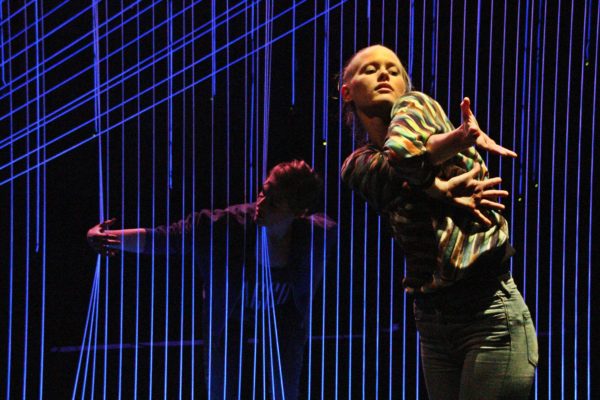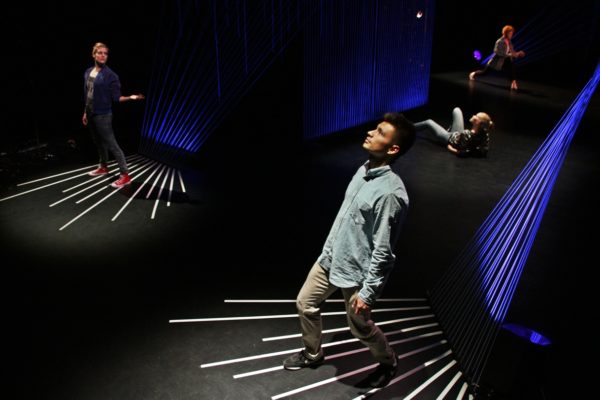Insomnia Festival and dancer/choreographer Mari Bø initiated Noise Control in 2013. Later on Mari Bø involved dancer and choreographer Silje Solheim Johnsen, musician and composer Gudmund Østgård. Together they wanted to do a dance performance with a focus on the perception of sound and how the different frequencies in sound move the body. With the performance Noise Control the audience is welcomed into the performance itself, people can wander around to experience different sounds and different dancers.
What was the inspiration & motivation behind the project?
Mari Bø: I have worked as a volunteer for the Insomnia festival for a couple of years, and I am also working as a freelance dancer and choreographer. My inspiration for starting this project actually came from the dancefloor at Insomnia: Tromsø is a small town and people are usually kind of typically Norwegian when they go out – to meet friends or to talk, maybe to dance a bit if the music is good. At Insomnia however, it is different. People go there purely to dance and experience new music.
One of the things I loved about my last few years at Insomnia was the dancefloor. It was full with people listening to the same music as me, but who are moving in totally different ways and tempi, facing different directions and generally doing their own thing regardless of the others. Even though they are listening to the same thing, they are experiencing and interpreting it differently.
For me this was very interesting. I work a lot with music in my dance performances, and the thought that my audience could be listening to the same thing, but actually hearing different things, was a new one. I find that people usually listen to different things in music; some people are preoccupied with the bass and the rhythm (that’s me), while others only listen to the melody, some only hear the lyrics and others only the tenors. As a dancer I feel that this individual interpretation probably also expands to the way we in turn watch movement: If you are listening to the bassline you might see something else in the movements than someone who is only listening to the lyrics.
Our idea was to explore this; to control the music that people are hearing (Noise Control), and therefore allow them to listen to something else than what they are used to, thereby maybe also see new ways of connecting music and movement. Filtering the music and portioning it out in different speaker solutions made it possible to listen to different things as you are moving around in the installation and seeing the dancers and the scenography from different angles.
Can you speak about the main idea of the performance – “ a focus on the perception of sound and how the different frequencies in the sound move the body”?
In Noise Control we are preoccupied with how the audience experiences music, but also how the dancers and musician experience it, and how it inspires us to move. We also wanted to challenge both ourselves and our audience to listen to something else in the music, and explore how this new way of listening might inspire other types of movement.
How was the experience of putting the performance together and working in interdisciplinary fields and with artists from different fields and media?
It has been a long and interesting journey for all the people involved. During the development of the project, we worked closely between the fields, meeting and jamming/bouncing ideas, but also filming/recording/drawing what we were working on, and sending it to each other. I like to think that the performance is a result of a genuine curiosity in music, movement, light and scenography, and a wish to understand and explore these fields together.
We have performed this project several times since the debut, and just a couple of months ago we were in Kristiansand, Norway, where we played 8 performances over 3 days. That was kind of exhausting, BUT something really interesting started to happen; we were so confident in the performance that all of us started to improvise and explore during; suddenly the music could change to something totally new, one of the dancers might have done something really unexpected, and the light design was constantly changing and evolving. I think the reason for this is that we have left the performance open towards all the different fields of art, allowing the performers to develop their fields.
What is the role of sound itself as a medium and also its relation to the human factor/aspect?
For me as a dancer, music is one of my main sources of inspiration, and I think that this performance is no different. The whole idea is based on the thought that people listen to music in different ways, and that this individual perception of sound in turn influences the way people experience other forms of art, for example movement. Therefore you can say that music and sound play a huge role in Noise Control, both being the glue that keeps all the fields together, but also being a huge inspiration and a major component in the experience as a whole. Personally I think that music and sound has a unique way of speaking to a lot of different people, calling forth different emotions and ideas.
What were the reactions of the public?
We had an overwhelming amount of positive feedback for the performance from a lot of different types of public; older people, youth, adults and children alike. It was really interesting to see how well they responded to it. One grown man actually said that he cried during the performance, while another person was a bit put off when he found out that he had to walk around the room. I thought that maybe it would be too loud for the kids, but it turned out that they enjoyed it a lot.
Was there anything that surprised you in relation to this project?
Yes! I had a great time researching different speaker solutions and exploring different ways of projecting sound. I think that the nicest surprise was the fact that we are still playing the performance, enjoying the constant improvisations and ways of challenging and surprising each other.
What is the current state of the project, are you planning any developments etc?
We’ve just finished our eight performances in Kristiansand, and are now working towards a tour, targeting our new youthful audience. We are planning to develop the scenography to make it easier to move around on tour. I think that Noise Control will continue to develop and evolve as we play more shows, and I find that very exciting.
Choreographers: Mari Bø & Silje Solheim Johnsen
Music: Gudmund Østgård
Dancers: Åsne Storli, Bao Andre Nguyen, Maria Landmark, Silje Solheim Johnsen & Mari Bø
Lighting design: Torbjørn T. Sandnes
Scenography: Mari Lotherington & Eirik Vagli Østbye
Photo & film: Jamie Michael Bivard

